Bringing a bit of nature inside can totally change the feel of your home. Plants just make any room feel more alive, but picking the right ones for your light situation? That’s not always so straightforward.
Remember to repin your favorite images!
Indoor plants all want different things—some love basking in bright sunlight, while others seem happiest tucked away in a dim corner.
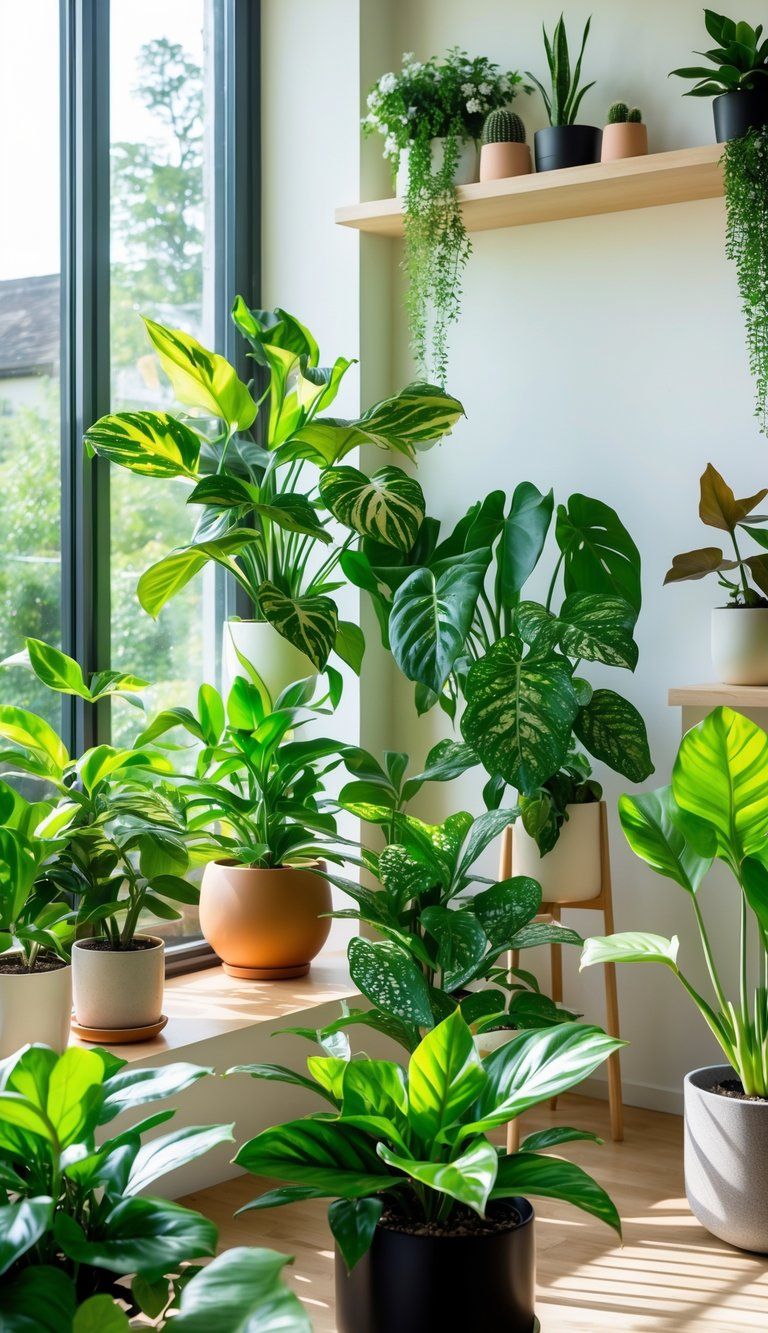
Maybe your place is full of big, sunny windows. Or maybe you’ve got dark, shadowy spots where the sun barely reaches. Either way, you’ll find a plant that fits.
Succulents soak up direct sunlight and don’t need much water. Dieffenbachia, on the other hand, shows off beautiful variegated leaves even when the light is pretty low.
If you want your indoor garden to really thrive, you’ve got to match your plants with their favorite lighting. Some, like Pothos, are super adaptable—you’ll see their vines growing just fine in both bright and medium light.
Once you get the hang of what each plant needs, you can fill every part of your home with greenery, no matter how much sunlight you get.
Understanding Light Conditions for Indoor Plants
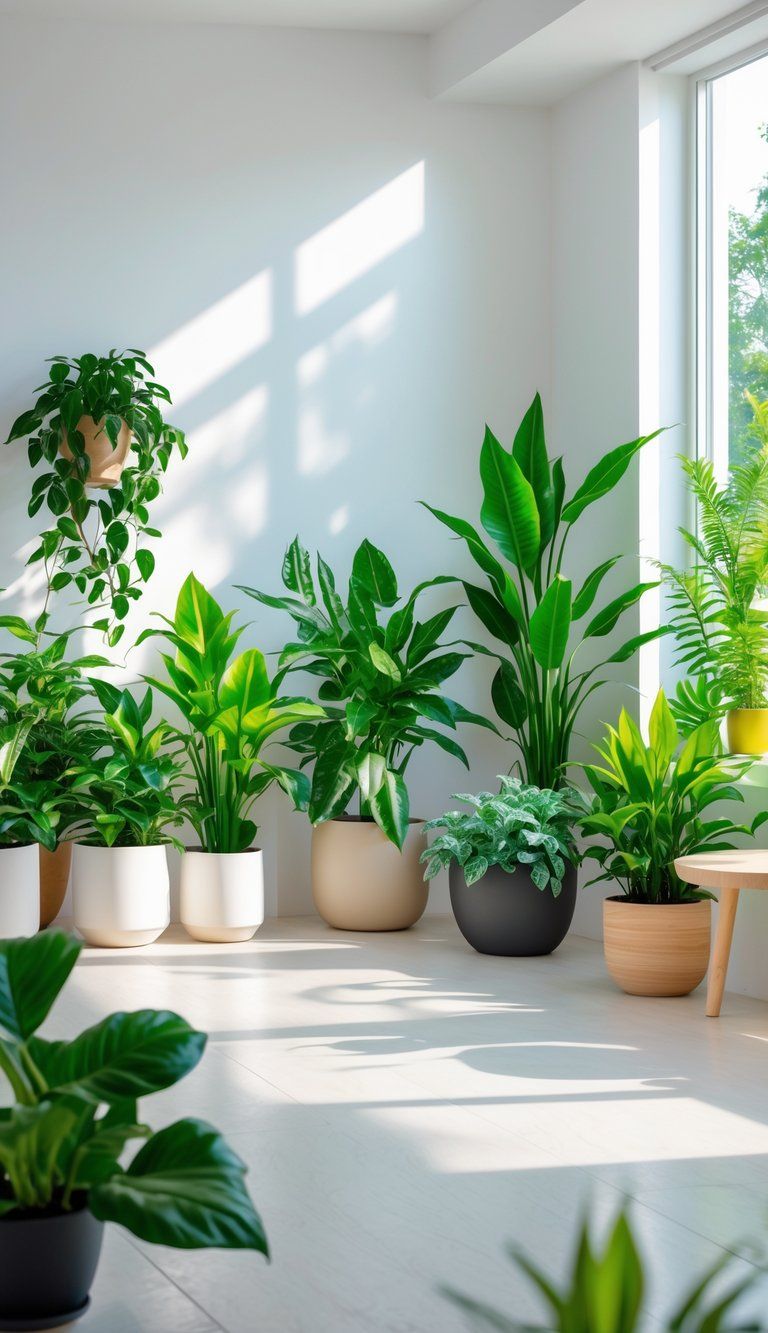
Light might be the single most important thing for your indoor plants. If you get it right, your plants will thank you. But if you get it wrong, they’ll probably let you know pretty quickly.
The amount and type of light in your home decides which plants will actually grow well.
Natural Light Versus Artificial Light
Most plants prefer natural light, but it changes a lot depending on the time of day and season. Morning light from the east is gentle and works for many plants. Southern windows get the strongest light.
Western sunlight in the afternoon can get a bit harsh and hot. Northern windows? They don’t get much light at all, but shade-loving plants still do fine there.
If you don’t have enough natural light, you can use artificial lighting. LED grow lights are a favorite—they’re efficient and give plants the wavelengths they crave. Fluorescent lights also work, especially for low-light plants and seedlings.
When you use artificial lights, keep them about 6-12 inches above your plants. Aim for 12-16 hours of light a day. Since artificial light isn’t as strong as sunlight, you might need to leave them on longer.
Bright, Indirect, and Low Light Explained
Bright light is usually found within three feet of a south or west-facing window. It measures about 1,000-5,000 foot-candles. Succulents, cacti, and lots of flowering houseplants love this spot.
Even indoors, direct light can burn sensitive leaves, so watch out for that.
Indirect light means the sun isn’t shining right on the plant. It’s filtered, maybe through a sheer curtain, or just a few feet away from the window. Most houseplants—think pothos, spider plants, and peace lilies—are happiest here.
Low light is what you get in north-facing rooms or spots far from windows. Only some plants put up with it, like snake plants, ZZ plants, and dracaenas. Growth will be slower, and you might lose some leaf patterns on variegated types.
Assessing Light Levels in Your Home
You don’t need fancy tools to figure out your light levels. Hold your hand about a foot above a surface—if you see a sharp shadow, that’s bright light.
A fuzzy shadow? That’s medium light. Barely any shadow means it’s low light.
If you want to get technical, download a light meter app or buy a cheap light meter. These measure in foot-candles or lux and help you pick the right spot for each plant.
Check light at different times of day, since it can really change. Morning and evening feel totally different, and the seasons matter too. What’s bright in summer could be just okay in winter.
Jot down notes about each spot in your home. This “light map” will make it way easier to choose plants that actually want what you already have.
Top Indoor Plants for Every Light Condition
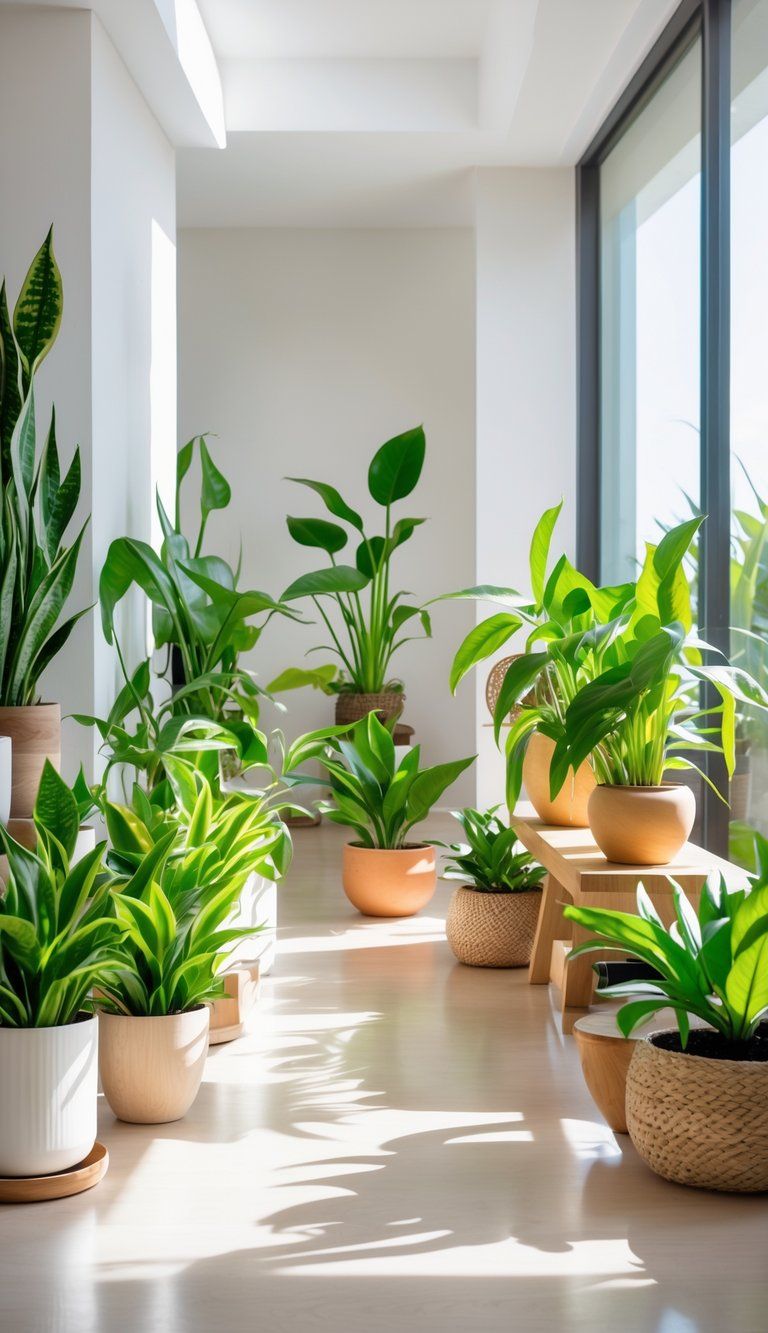
Picking the right plant mostly comes down to the light in each room. Here are some great choices for everything from dark corners to sunny windowsills.
Low-Light Champions
Snake Plant (Sansevieria) really doesn’t care if it’s stuck in a dark corner. Its upright, sword-like leaves look sharp in any space. You can get away with watering it only every few weeks.
ZZ Plant is a survivor, thriving even when you forget about it. Its glossy, deep green leaves and water-storing roots make it super low maintenance.
Pothos vines just keep growing, even in low light. Golden Pothos adds some pretty variegation. Hang them up and let those vines trail down.
Cast Iron Plant lives up to its tough name. Its broad, dark leaves rarely show damage and can handle even the gloomiest spots.
Chinese Evergreen (Aglaonema) brings pops of color, even when the light is lacking. Newer types have pink, red, or cream patterns.
Plants Thriving in Bright, Indirect Light
Peace Lily (Spathiphyllum) gives you those lovely white blooms in moderate light. Its leaves droop when thirsty, so it’s easy to tell when it needs water.
Monstera Deliciosa is the one with the big, split leaves. It likes to sit a few feet from a window, soaking up filtered light. Young Monsteras start with solid leaves, but as they grow, those cool holes appear.
Philodendron—Heartleaf or Brasil—are super forgiving. They’ll let you know when they’re thirsty by drooping a bit.
Prayer Plant (Calathea) shows off wild leaf patterns and actually moves its leaves up at night. Keep it out of direct sun to avoid crispy edges.
Bird’s Nest Fern loves humidity and soft light. It’s easier to care for than most ferns and has funky, wavy fronds.
Sun-Loving Indoor Varieties
Bird of Paradise (Strelitzia reginae) wants as much sun as you can give it. With enough light, you might even see those amazing orange and blue flowers.
Succulents and Cacti need at least six hours of bright light a day. South-facing windows are perfect. They hardly need water—maybe every couple weeks.
Croton puts on a show with bold yellow, orange, and red leaves, but only if you give it plenty of sun. Not enough light, and it’ll just stay green.
Aloe Vera is both pretty and practical. It likes its soil dry and wants bright, direct light to keep its tidy shape.
Areca Palm (Dypsis lutescens) loves a bright room and helps clean your air. Unlike some palms, it can handle full sun and will eventually become a lush, tropical focal point.
Low-Light Indoor Plants That Flourish
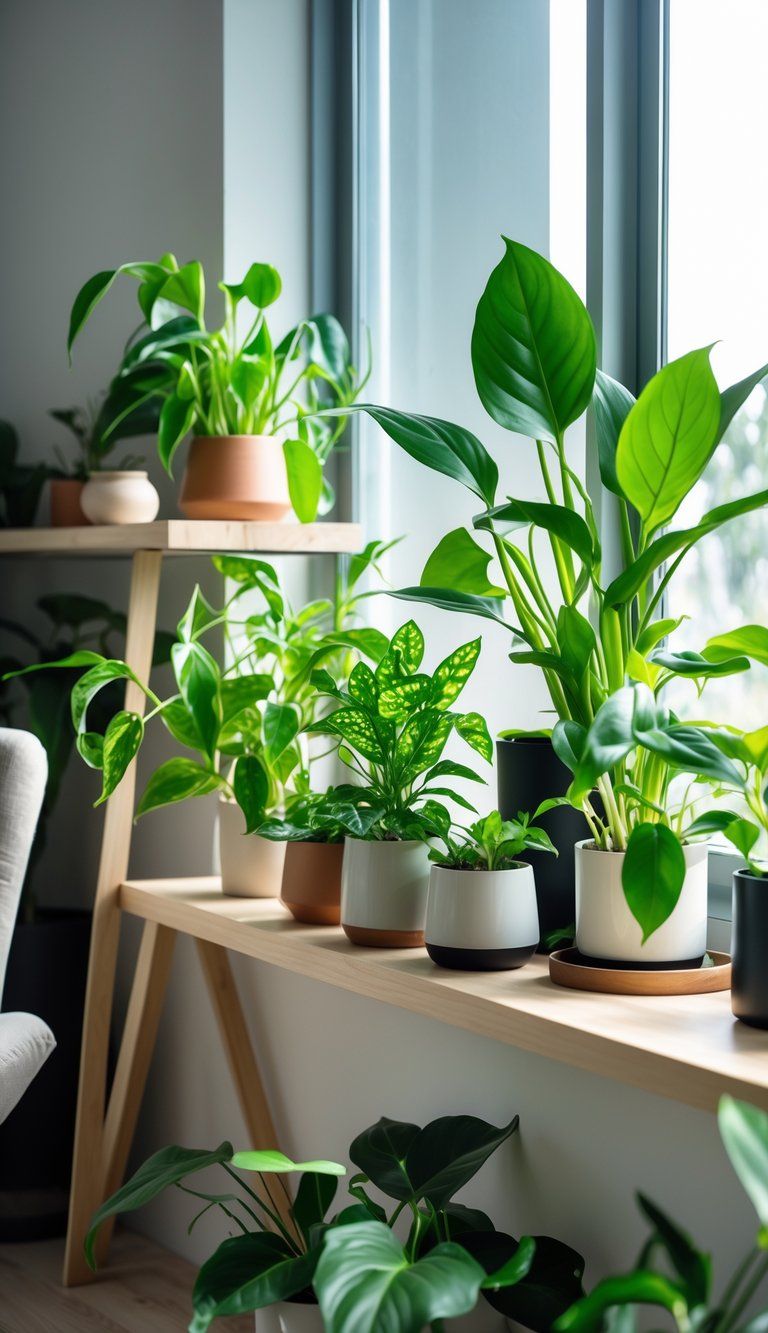
Not every corner of your home gets tons of sunlight, but you don’t have to leave those spots bare. Plenty of gorgeous plants grow just fine in low light, and some even help clean your air.
Snake Plant and Mother-in-Law’s Tongue
Snake plants (Sansevieria) are practically unkillable. They’ll put up with low light and long stretches without water. The leaves are tall and sword-like—some varieties reach up to eight feet.
Mother-in-Law’s Tongue adds yellow margins for a little extra style. Both types help filter out nasty stuff like formaldehyde and benzene from your air.
Care tips:
- Only water when the soil is bone dry
- Use soil that drains well
- Forget about them for a while—they’ll be fine
- Survive in almost any indoor lighting
You don’t need to repot snake plants often, and they can stick around for decades. They’re awesome for bedrooms, since they release oxygen at night.
ZZ Plant and Cast Iron Plant
ZZ Plants have shiny, dark green leaves on arching stems. They store water in thick rhizomes, so you can forget to water them for weeks.
Cast Iron Plants are just as tough. Their broad, leathery leaves stay deep green, even in the darkest corners.
Both plants:
- Survive drought with ease
- Handle almost no light
- Resist most pests and diseases
- Need very little attention
You only need to fertilize once or twice a year. These are perfect for offices, hallways, or bathrooms with barely any sunlight. ZZ Plants can go a month between waterings, while Cast Iron Plants like a little more regular moisture.
Aglaonema, Dumb Cane, and Chinese Evergreen
Chinese Evergreens (Aglaonema) brighten up low-light spots with leaves splashed in silver, pink, or red. They stay compact and look great on shelves or tables.
Dumb Cane (Dieffenbachia) has big, speckled leaves for a tropical vibe. Don’t let pets or kids chew on them, though—the sap isn’t safe.
Growing tips:
- Keep soil just a bit moist
- Add humidity with misting or a pebble tray
- Wipe leaves to keep them shiny
- Keep away from cold drafts
Try to avoid placing them near air vents. They like it warm—between 65-80°F is best. Most will top out at two or three feet indoors.
Heartleaf Philodendron and Pothos Varieties
Heartleaf Philodendrons have cute, heart-shaped leaves on long, trailing vines. They adapt to all sorts of lighting and don’t mind if you forget to water now and then.
Pothos, especially Golden Pothos, are just as easygoing with their yellow-green marbled leaves. You can let them climb or hang down—it’s up to you.
How to display:
- Hang them up to show off those vines
- Let them climb a moss pole
- Trim for tabletop growth
- Try wall planters for something different
When the leaves droop a bit, it’s time to water. Both are super easy to propagate—just snip a vine with a node and stick it in water. They’ll grow faster in brighter spots, but low light won’t bother them much.
Best Plants for Bright, Indirect Light
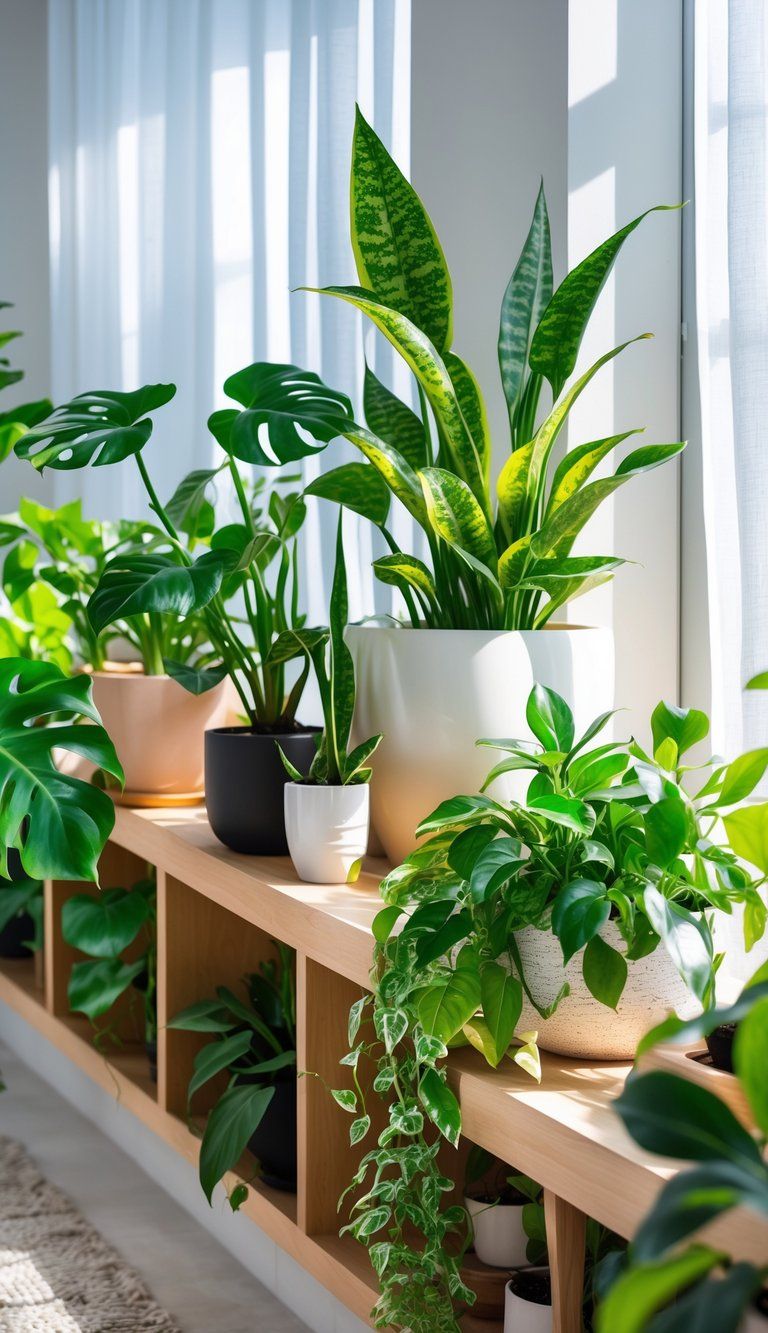
Bright, indirect light creates a sweet spot for a lot of houseplants. They soak up plenty of light without getting scorched by harsh rays.
Monstera and Swiss Cheese Plant
Monstera deliciosa, or Swiss Cheese Plant, is a real showstopper for these conditions. As it grows up, you’ll see those signature holes pop up in its big, glossy leaves.
Monsteras like to sit about three to five feet from a window. If you keep them too far from the light, they’ll grow slowly and the leaves might not get those cool holes. Too much direct sun, though, and the leaves can burn.
These plants can get impressively tall indoors—sometimes up to eight feet! They prefer:
- Soil that stays moist but never soggy
- Regular misting for extra humidity
- Something to climb as they get bigger
Once established, Monsteras don’t ask for much. Wipe down those big leaves every now and then so they keep looking their best.
Peace Lily and Spathiphyllum
Peace lilies (Spathiphyllum) bring elegance with their glossy, deep green leaves and those striking white “flowers”—which, fun fact, are actually modified leaves called spathes.
They add a sophisticated vibe to any room, don’t they?
These plants thrive best in bright, indirect light, but honestly, they handle low light better than most houseplants.
Try putting yours near a north or east-facing window for happy growth.
Peace lilies make their needs obvious, which is kind of refreshing:
- Drooping leaves? They want water.
- Yellow leaves? Probably too much sun.
- No blooms? Most likely not enough light.
Keep their soil consistently moist, but if you forget to water now and then, they bounce back pretty fast.
Besides looking good, peace lilies pull toxins like benzene and formaldehyde from the air, making your space healthier.
Fiddle Leaf Fig and Ficus lyrata
The fiddle leaf fig (Ficus lyrata) has taken over design magazines with its violin-shaped leaves and bold, upright growth.
It really transforms a space with its dramatic look.
Fiddle leaf figs need bright, indirect light to stay healthy.
Put yours near a window with filtered sunlight—maybe behind a sheer curtain—and give it a little turn every so often so all sides get light.
Caring for these plants can be a bit of a challenge:
- Only water when the top 1-2 inches of soil are dry.
- Keep the environment steady; they hate drafts and sudden changes.
- Wipe the leaves now and then to help them soak up more light.
If you stick with it, your fiddle leaf fig can grow impressively tall—sometimes 6-10 feet indoors.
They might be a bit fussy, but their sculptural look makes all that effort feel worth it.
Sun-Loving Houseplants for Direct Light
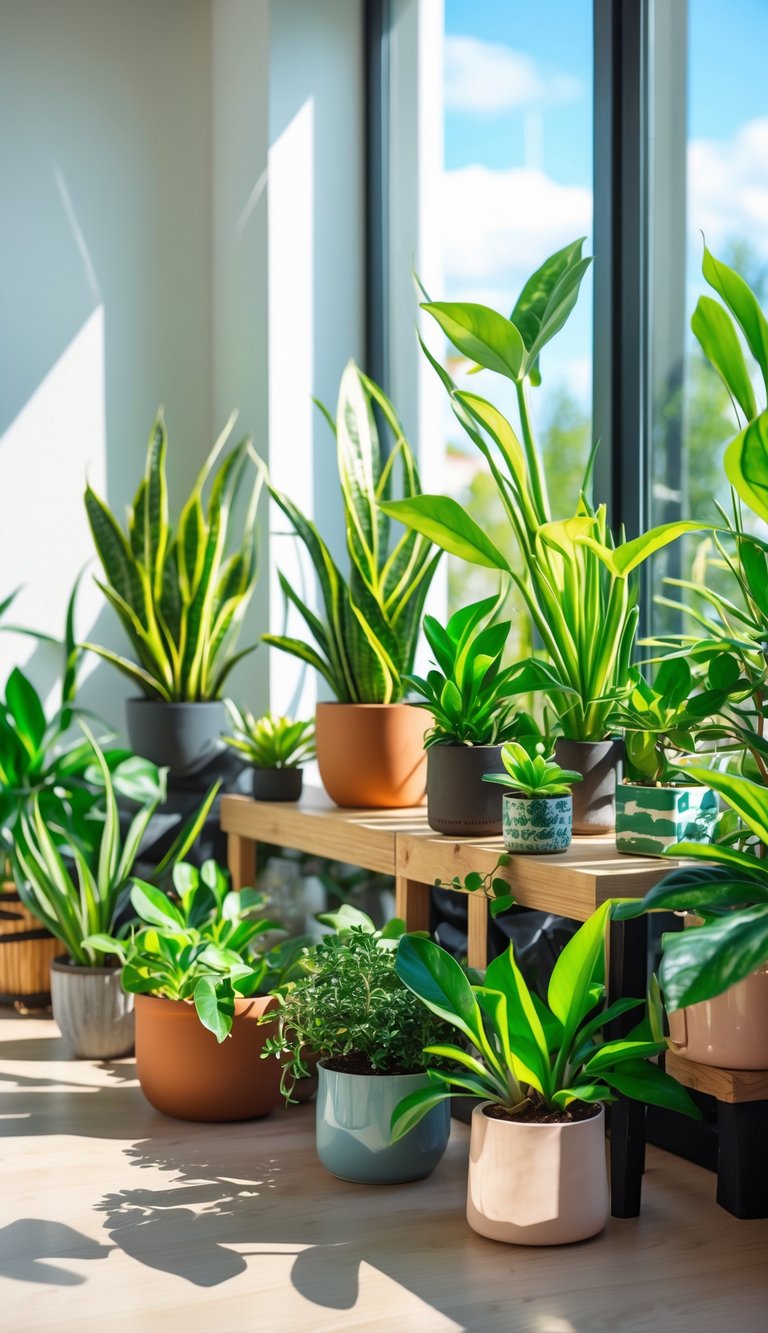
Some houseplants crave bright, direct sunlight—the kind that would fry more sensitive plants.
These sun-lovers soak up the rays and reward you with vibrant growth if you give them the sunniest spot in your home.
Orchids and Succulents
Certain orchids, like Vanda, absolutely thrive in direct sunlight.
Place them in a south-facing window, and you’ll see those wild roots and vivid blooms pop.
These orchids are used to tropical sun and want 4-6 hours of direct light every day.
Succulents are built for sun, too.
Echeveria, haworthia, and sedum have thick, water-storing leaves that love direct sunlight.
Line them up on your brightest windowsill, and they’ll stay compact and show off brighter colors.
Tips for happy succulents:
- Only water when the soil is bone dry.
- Use a gritty cactus mix.
- Give them a spin sometimes for even growth.
- Notice if leaves turn red or purple? That’s them enjoying the sun.
Aloe Vera and Jade Plant
Aloe vera really needs a few hours of direct sun daily to stay plump and upright.
Its thick leaves hold water and that soothing gel inside.
Give it a west or south window, and it’ll thank you.
Jade plants (Crassula ovata) are tough, too.
With woody stems and oval leaves, they’re often called “money plants” and are said to bring prosperity.
Lots of sunlight helps them grow thick and tree-like.
Both aloe and jade can handle a bit of neglect.
Let their soil dry out fully between waterings, or you risk root rot.
Bird of Paradise and Bromeliads
Bird of Paradise (Strelitzia reginae) grabs attention with its huge, paddle-like leaves.
It needs direct sunlight and, if you’re patient, might even bloom with those wild bird-shaped flowers after a few years.
Aim for 4-6 hours of sun each day.
Bromeliads bring a tropical vibe to sunny rooms.
Varieties like Guzmania and Aechmea can handle direct light and send up colorful flower spikes that last for ages.
Their cup-shaped centers hold water, creating a little oasis for the plant.
For both:
- Keep the soil moist but not soggy.
- Mist once in a while for humidity.
- Fertilize every month during growing season.
- Be patient—Bird of Paradise can take years to flower indoors.
Versatile Plants That Adapt to Multiple Light Conditions
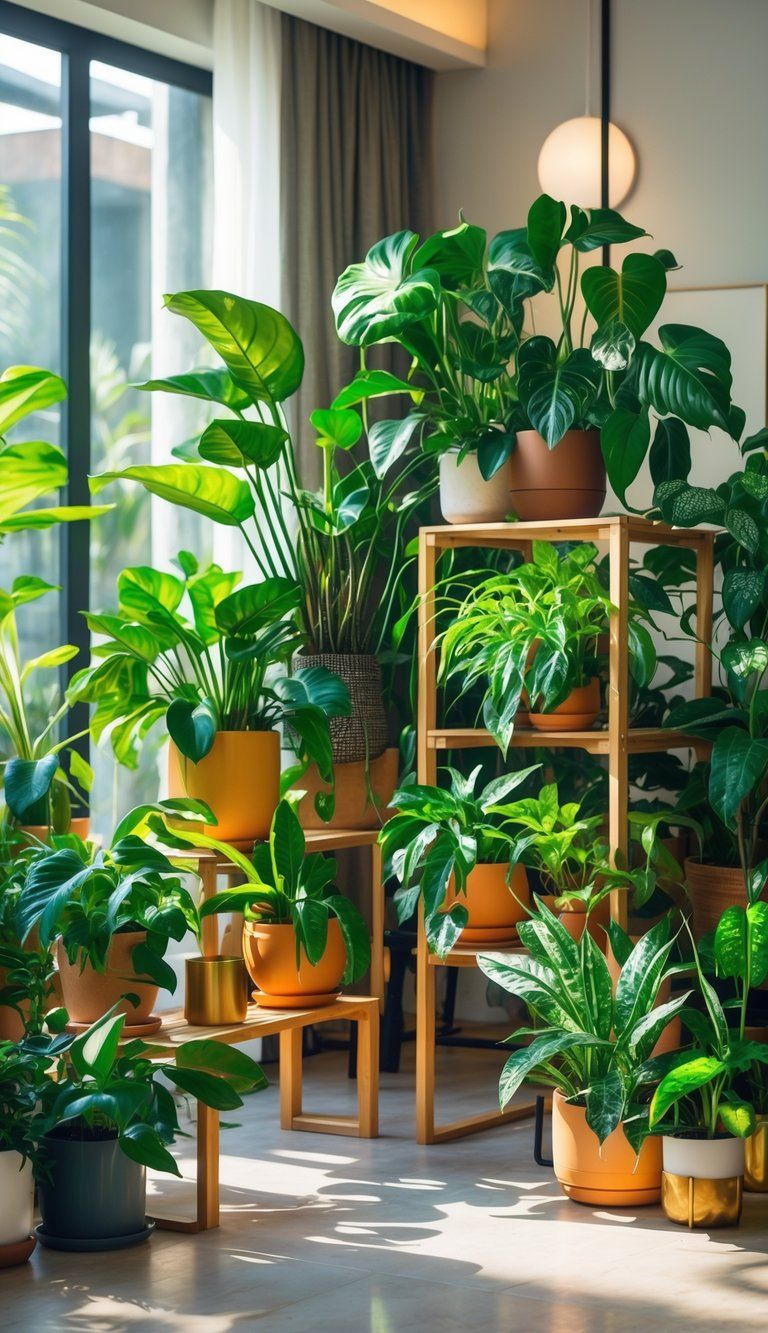
Some houseplants just roll with the punches, thriving in all sorts of lighting.
They’re perfect if your space gets different light throughout the day or you like to move things around.
Spider Plant and English Ivy
Spider Plants are almost impossible to mess up when it comes to light.
They grow in low light or bright indirect light, so you can put them pretty much anywhere.
Their green-and-white striped leaves arch out and send down baby plants, called “spiderettes,” for extra charm.
Spider Plants need very little from you—just water when the soil feels dry.
They’ll keep growing and even help clean your air.
English Ivy also adapts well to different light levels.
It prefers bright, indirect light but doesn’t mind a dim corner.
This trailing plant looks great in hanging baskets or climbing a trellis.
Keep the soil moist, but if you forget now and then, it usually bounces back.
Its variegated leaves add texture and a classic look to your home.
Dracaena and Dragon Tree
Dracaena plants stand out with their striking, sword-like leaves.
They like medium to bright indirect light but can slow down and still survive in less light.
You’ll find them in lots of colors and patterns, from solid green to striped or edged in different shades.
Dracaenas don’t need much water—just wait until the top inch of soil dries out.
Varieties like Corn Plant and Warneckii are especially easygoing.
Dragon Trees (Dracaena marginata) have thin, arching leaves on slender stems.
They handle everything from moderate to bright indirect light, though the color fades a bit in dimmer spots.
Dragon Trees can get pretty tall indoors—sometimes up to 10 feet—but they grow slowly.
They’re dramatic and need very little attention.
Rubber Plant and Mass Cane
Rubber Plants have thick, glossy leaves that make a bold statement.
They love bright, indirect light but will put up with medium light, just growing a bit slower.
Here’s what they need:
- Water when the top inch of soil dries out.
- Wipe the leaves now and then.
- With good care, they can become small indoor trees.
Mass Cane (Dracaena fragrans “Massangeana”) sports corn-like leaves with yellow-green stripes.
It adapts to all sorts of lighting, from low to bright indirect, though medium light is ideal.
Mass Cane is low-maintenance and shrugs off a bit of neglect.
It grows slowly, usually reaching 4-6 feet indoors, and doesn’t need frequent repotting.
Plus, it helps clean the air, so it’s both pretty and practical.
Plant Care Essentials for Healthy Indoor Gardens

Keeping indoor plants alive isn’t rocket science, but it does take some attention.
If you focus on watering, soil, and checking for pests, your plants should do just fine.
Watering and Humidity Requirements
Most people kill houseplants by overwatering, not by forgetting to water.
Stick your finger about an inch into the soil; if it feels dry, go ahead and water.
Every plant has its quirks.
Succulents and cacti want to dry out completely between drinks, while ferns and other tropicals need more consistent moisture.
Humidity is another thing to consider, especially if your house is dry.
You can bump up the humidity by:
- Grouping plants together
- Setting pots on pebble trays with water
- Using a humidifier
- Misting plants that love moisture (though that’s just a temporary fix)
When winter rolls around, cut back on watering since plants slow down.
In summer, you’ll probably water more often as soil dries quicker.
Fertilization and Soil Type
The right soil gives your plants nutrients and good drainage.
Most houseplants do best in a well-draining potting mix—not regular garden dirt.
For fertilizer:
- Feed during the growing season (spring and summer).
- Use a balanced houseplant fertilizer—something like 10-10-10.
- Dilute it to half strength.
- Skip fertilizing new or dormant plants.
Soil tweaks help too.
Mix perlite or sand into your potting mix for succulents and cacti.
For moisture-loving plants, add peat moss or coco coir.
Too much fertilizer can burn your plants, leaving brown tips or stunted growth.
If you aren’t sure, it’s safer to use less rather than more.
Pest Prevention and Disease Control
Check your plants regularly for pests.
Look over new arrivals before bringing them home, and give your existing plants a weekly once-over.
Watch out for:
- Spider mites (tiny dots with webbing)
- Mealybugs (white, cottony blobs)
- Fungus gnats (little flying bugs)
- Scale (brown bumps on stems and leaves)
If you catch pests early, wipe leaves with soapy water or spray with neem oil.
Tougher infestations might need insecticidal soap.
To prevent disease, avoid getting leaves wet and don’t crowd your plants.
Keep air moving around them.
If you spot infected leaves or plants, remove them right away to stop the spread.
Quarantine new plants for a week or two before mixing them in with your others.
It’s a simple step that can save you a lot of headaches later.
Low-Maintenance Houseplants for Busy Lifestyles
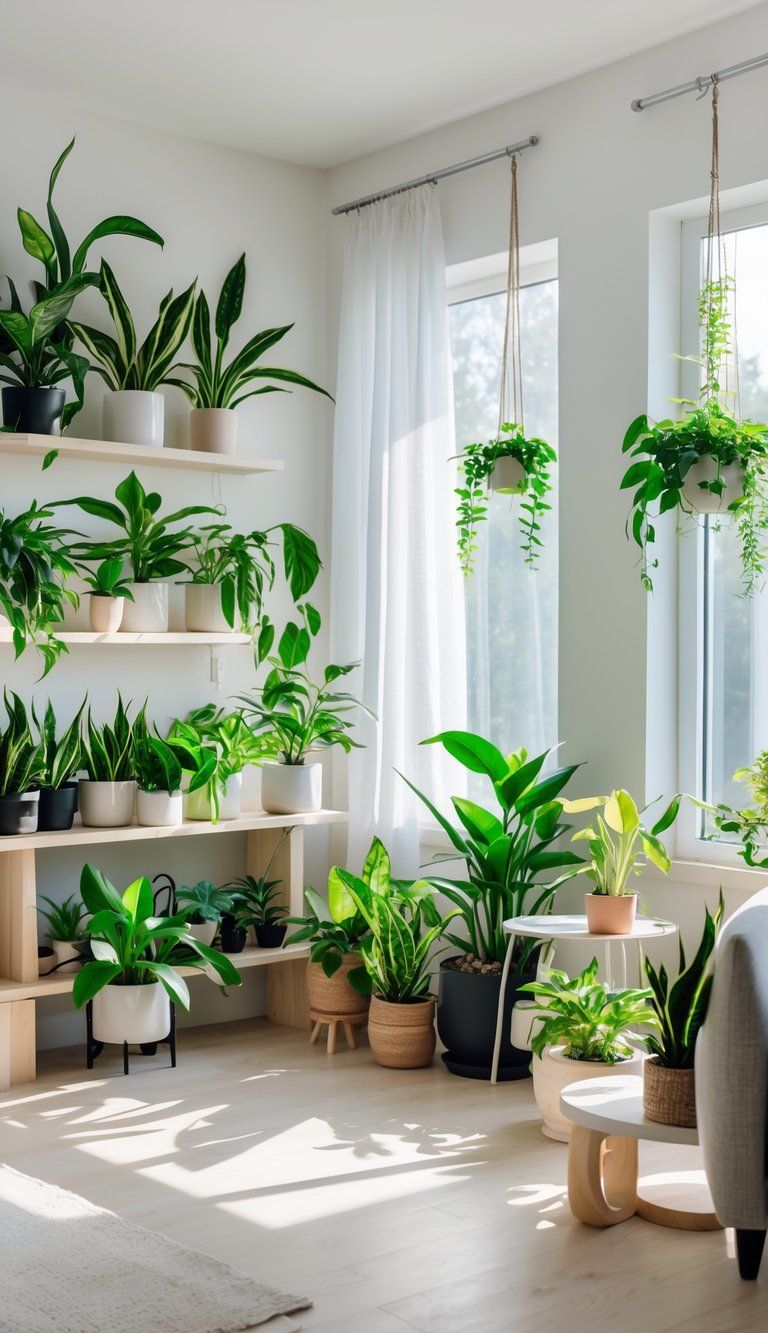
Let’s be honest—not everyone has time to fuss over plants.
Some houseplants practically thrive on neglect, making them perfect for busy folks or beginners.
ZZ Plant and Snake Plant
ZZ Plants are about as low-maintenance as it gets.
Their shiny, dark green leaves look classy and can handle low light.
Water every 2-3 weeks, and they’ll keep going strong.
ZZ Plants store water in their stems and roots, so forgetting to water isn’t a big deal.
Snake Plants (Sansevieria) are just as tough.
Their tall, upright leaves come in lots of patterns and colors.
They don’t mind low light or bright light and want their soil to dry out completely before you water again.
Both plants help clean the air and rarely need repotting.
Just dust their leaves once in a while to keep them looking sharp.
Pothos and Golden Pothos
Pothos vines are the ultimate “set it and forget it” plants.
They trail from shelves or hang in baskets, showing off heart-shaped leaves that brighten up any spot.
Pothos grows in anything from low to bright indirect light.
Water when the soil feels dry about an inch down.
Golden Pothos, with its streaks of yellow and green, is especially tough.
It even tells you when it’s thirsty by drooping a bit, then perks up fast after watering.
These plants are hard to kill and bounce back from a lot.
A few tips:
- Water every week or two.
- Trim to keep it bushy.
- Wipe leaves with a damp cloth now and then.
- Propagate in water for easy new plants.
You’ll spot new leaves when your Pothos is happy.
Air Purifying Indoor Plants and Health Benefits
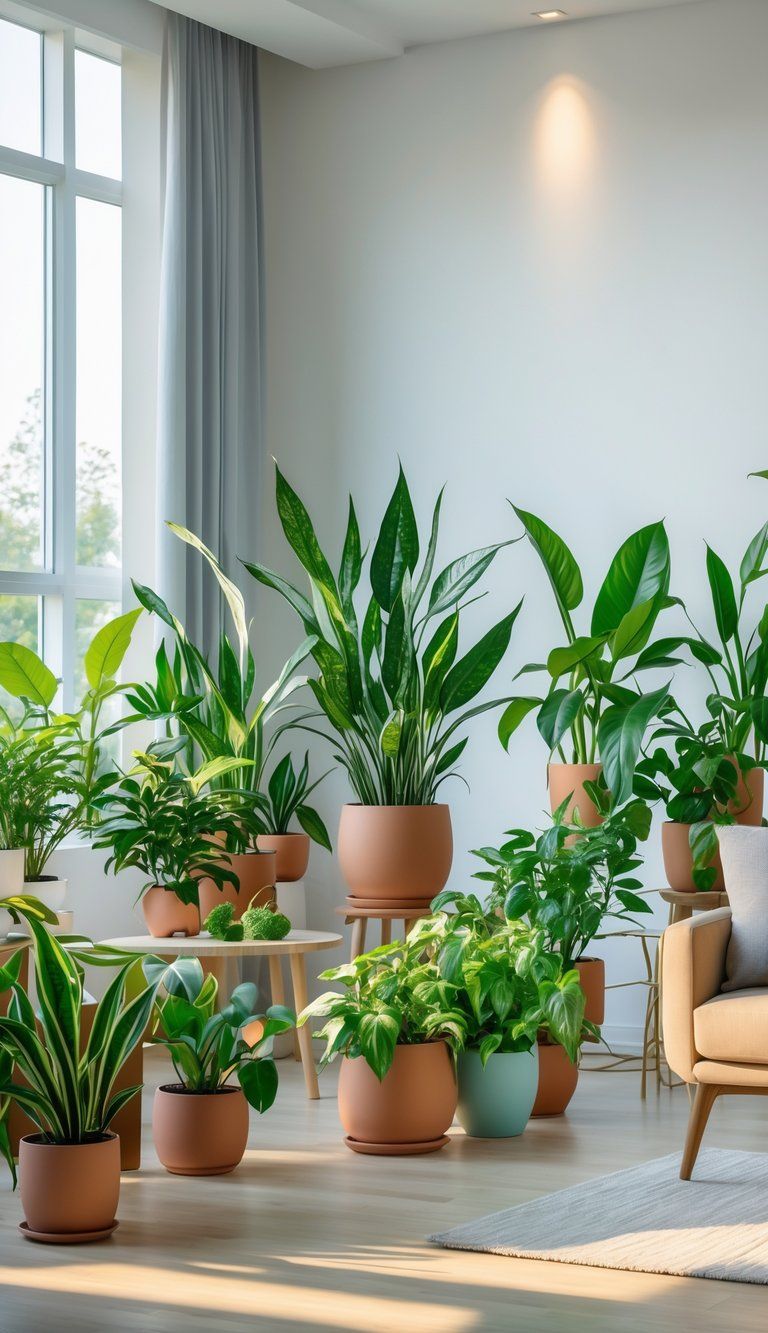
Indoor plants aren’t just for looks.
They help clean your home’s air and can boost your well-being.
Studies show that certain plants remove harmful chemicals and actually improve indoor air quality.
Improving Air Quality with Houseplants
Plants act as natural air purifiers. They pull pollutants in through their leaves and roots.
That well-known NASA study? It showed that certain plants can remove toxins like formaldehyde, benzene, and trichloroethylene from indoor air. Pretty wild, right?
You’d technically need a ton of plants—some studies say 100 to 1000 per 10 square feet—to see a huge impact. But honestly, even a handful seems to help.
Offices with plants saw real changes. Workers had 24% fewer headaches and 52% less eye irritation.
Respiratory issues dropped by 34%, too. That’s not nothing.
Plants also bump up humidity and add oxygen, which just makes a space feel better. In winter, when the air gets so dry, that extra moisture is a relief.
Top Air Purifier Plants for the Home
Peace Lily: This beautiful flowering plant actually pulls common indoor pollutants out of the air. It does well in low to medium light. Just water it when the soil feels dry—no need to fuss.
Spider Plant: If you want something easy, go for a spider plant. It grabs formaldehyde and other toxins from your space. Plus, it handles all sorts of lighting and grows little “babies” you can share or repot.
Rubber Plant: The rubber plant stands out visually and tackles formaldehyde too. It likes medium to bright, indirect sunlight. Wait until the soil dries out before watering again.
Dracaena: You’ll find dracaena in a bunch of varieties. They filter out benzene, formaldehyde, and even trichloroethylene. They’re pretty flexible with lighting, but honestly, they seem happiest with indirect light.
Parlor Palm and Areca Palm: These palms do a great job cleaning the air and, let’s be honest, make any room feel a bit more tropical. They prefer bright, indirect light, though they’ll tolerate medium light if that’s all you’ve got.

